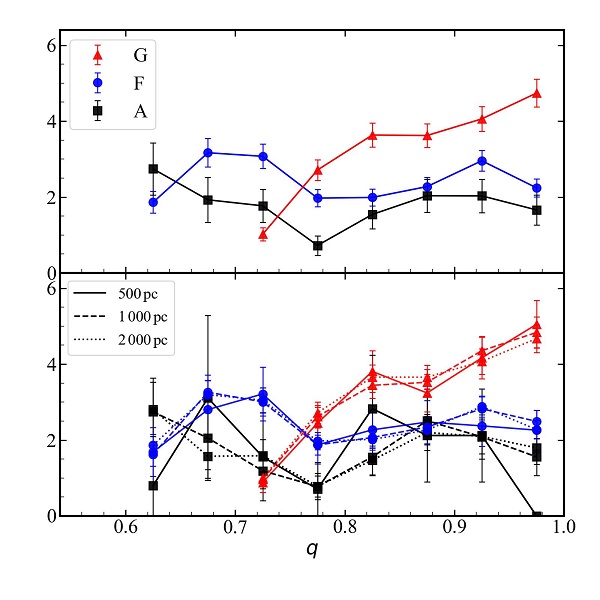Most of what we know about the universe comes from studies on stars, and about half of the stars are found to be in binary systems. The close binary interaction between the stellar components may change the destiny of the stars. Li et al. (2022) recently devised a new approach to investigate the mass-ratio distribution of binary stars identified from the Large Sky Area Multi-Object Fiber Spectroscopy Telescope using the medium-resolution Survey (LAMOST-MRS). The mass-ratio distribution and binary fractions are significant for the study of the binary formation and binary evolution. This work was published recently in The Astrophysical Journal.
Binarity is common among stars. The binary fraction is up to 70% for massive stars, while such fraction drops down to 44% for solar-type stars. Such information suggests that the binary fraction plays a non-negligible role in the binary population. Binary evolution may result in the formation of stellar objects with exotic observational phenomena crucial for the development of astrophysics, such as Type Ia supernovae, double black holes, double neutron stars, millisecond pulsars and X-ray binaries. The compact systems contribute to the chemical evolution of galaxies and provide re-ionizing photons of the early universe.
Observational properties of binary populations are vital inputs to understanding binary evolution. These include binary fraction, binary orbital period distribution, mass-ratio distribution, and the dependence of the distribution on the stellar spectral type and metallicity. The statistical properties of the binary population are poorly understood due to an absence of a large and consistent sample available. However, such a situation has drastically changed thanks to the large sample of spectroscopic observations obtained from the LAMOST-MRS, which allow the researchers to investigate the properties of mass-ration distribution and binary fraction.
Researchers devised a peak amplitude ratio (PAR) approach to derive the mass ratio of double-lined spectroscopic binaries identified from the LAMOST-MRS survey. An example of a schematic illustration of a binary system is shown in Figure 2. Based on the different radial velocities measured from the component stars in a binary system, a system was identified as a double-lined spectroscopic binaries(SB2) system when two peaks appeared in the cross-correlation functions (CCFs). The PAR of the CCF peaks may depend on the mass ratio of the binary system (q = m2/m1). By using the spectral observations obtained from the LAMOST-MRS Data Release 6 and 7, the researchers applied this PAR approach to form distributions of the derived mass ratio of the binary systems to their spectral types (including A-, F-, and G-type), and the results are shown in Figure 3. The researchers found that G-type stars are likely to be found as twins.
Contact:
LI Jiangdan
Yunnan Observatories, CAS
Email: lijiangdan@ynao.ac.cn

Figure1 A schematic diagram of the binary system (cited: European Southern Observatory)

Figure 2 An example spectrum and computed CCF. The upper panel shows the observed spectrum of the identified binary system, in which the primary has an estimated effective temperature of 6400 K, and this system has a derived mass ratio q = 0.79. The lower panel shows the computed CCF of the spectrum with a model spectrum spanning from -500 km/s to 500 km/s. Two peaks were identified from the CCFs: a primary peak with a measured height of 0.73 and radial velocity of -83 km/s and a secondary peak height of 0.61 with a measured RV of 17 km/s.

Figure 3 The mass ratio distribution of SB2 systems was identified from the LAMOST-MRS. The upper panel shows the density for A- (black square), F- (blue circle), and G-type (red triangle) binaries. The bottom panel shows a similar distribution for the SB2 binaries with subsets grouped by their distance, including SB2 binaries observed within 500 pc (solid line), 1000 pc (dashed line), and 2000 pc (dotted line).